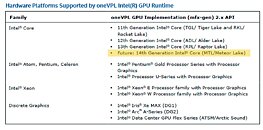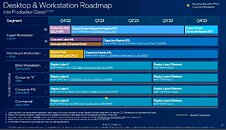- Joined
- Oct 9, 2007
- Messages
- 47,675 (7.43/day)
- Location
- Dublin, Ireland
| System Name | RBMK-1000 |
|---|---|
| Processor | AMD Ryzen 7 5700G |
| Motherboard | Gigabyte B550 AORUS Elite V2 |
| Cooling | DeepCool Gammax L240 V2 |
| Memory | 2x 16GB DDR4-3200 |
| Video Card(s) | Galax RTX 4070 Ti EX |
| Storage | Samsung 990 1TB |
| Display(s) | BenQ 1440p 60 Hz 27-inch |
| Case | Corsair Carbide 100R |
| Audio Device(s) | ASUS SupremeFX S1220A |
| Power Supply | Cooler Master MWE Gold 650W |
| Mouse | ASUS ROG Strix Impact |
| Keyboard | Gamdias Hermes E2 |
| Software | Windows 11 Pro |
Intel is planning to update its desktop processor product-stack in the second half of 2023 with the Core "Raptor Lake Refresh" series. A VideoCardz report suggests that these chips could remain a part of the 13th Gen Core series, and Intel will not carve the 14th Gen Core out of them. This would be similar to how Intel dealt with delays in the commissioning of its 14 nm node by releasing the "Haswell Refresh" and "Devil's Canyon" processors within the 4th Gen Core family. Intel tried something different with "Coffee Lake Refresh," by branding it inside the 9th Gen Core series, instead of keeping it within the 8th Gen Core. This was done because Intel updated the CPU core-counts of its Core i7 SKUs, and introduced the new Core i9 brand extension for the mainstream-desktop segment.
If 4th Gen Core "Haswell Refresh" is anything to go by, Intel could use updated xx50 processor model numbers for "Raptor Lake Refresh" processors. An example of such a naming scheme would be the Core i9-13950K, which succeeds the i9-13900K (the i9-13900KS is a limited edition / limited-release SKU). At this point we don't know what exactly constitutes this Refresh, other than the high likelihood of clock-speed increases across the board. It's possible that Intel may innovate in the areas of die-thinning, die-binning, and process-level power improvements that open up room for these higher clock-speeds (which is what Intel did with 10th Gen "Comet Lake"). These processors could be built in the existing Socket LGA1700 package, and be compatible with existing Intel 600-series and 700-series chipset motherboards, requiring a UEFI firmware update.


View at TechPowerUp Main Site | Source
If 4th Gen Core "Haswell Refresh" is anything to go by, Intel could use updated xx50 processor model numbers for "Raptor Lake Refresh" processors. An example of such a naming scheme would be the Core i9-13950K, which succeeds the i9-13900K (the i9-13900KS is a limited edition / limited-release SKU). At this point we don't know what exactly constitutes this Refresh, other than the high likelihood of clock-speed increases across the board. It's possible that Intel may innovate in the areas of die-thinning, die-binning, and process-level power improvements that open up room for these higher clock-speeds (which is what Intel did with 10th Gen "Comet Lake"). These processors could be built in the existing Socket LGA1700 package, and be compatible with existing Intel 600-series and 700-series chipset motherboards, requiring a UEFI firmware update.


View at TechPowerUp Main Site | Source







